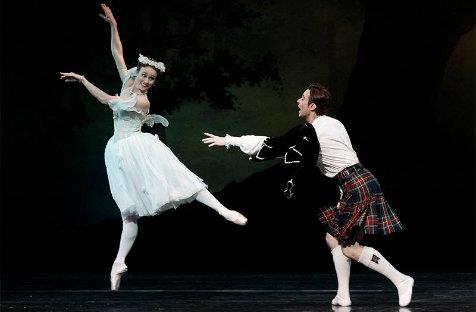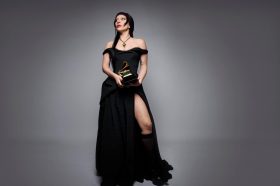The Australian Ballet’s production of La Sylphide dominated the publicity, the program and even the cast sheet – so it was certainly intended to be the drawcard in this two-part offering. Fair enough. It is longer than the first work, Paquita, and presents as a story-ballet, traditionally popular with a wide audience.
However, choreographed by Petipa to music by Minkus, Paquita deserved more attention. A series of set-pieces, the work is an Australian Ballet standard (this was the 63rd performance) and a showpiece for eight soloists. Notable was the Grand pas de deux, danced by Olivia Bell and Adam Bull, which began slowly and gracefully but gave these eminently watchable dancers plenty of opportunity to show why they are Principals in the company.
Orchestra Victoria, under guest conductor Philip Ellis, provided fine support throughout the night, with both ballets drawing on Mary Anderson’s harp for effect. The Paquita set was unremarkable, with two chandeliers rather oddly positioned against a starry sky. No doubt this was for practical reasons as, once again, the set for La Sylphide had first call on the generous stage.
Scottish Gothic in style, the setting was described as ‘James’ farmhouse’ but appeared grander, thanks in part to the staircase and fireplace – necessary to the story as an escape route for the Sylphide (Leanne Stojmenov), a woodland sprite. To the accompaniment of a solo violin, from curtain-up, the Sylphide gets to work on her pursuit of James (Kevin Jackson) who is supposed to be marrying Effie (Vivienne Wong) that very day. Any seasoned ballet fan knows that’s not going to happen!
The convoluted plot includes James’ cousin Gurn (Jarryd Madden) winning Effie, the Sylphide’s eventual death and the interference of a truly hideous witch called Madge (Colin Peasley).
In between all that, there is plenty of lovely dancing. Anne Fraser’s costumes for Effie’s friends are a light, pretty take on Scottish tartans – and the men seemed to relish the freedom of dancing in kilts.
The choreography (listed as Erik Bruhn after August Bournoville) makes the most of the work’s contrasts, with the Second Act’s ‘woodland glade’ allowing for drifting sylphides in contrast to the energetic Scots of the First. Pivotal to the work’s original success was the pointe shoe, and Romantic sensibility that took to the idea of the ‘ballet blanc …[with] … scenic groupings of women in diaphanous tutus’ (as the program noted).
With less of a challenge than in her recent role as Odette in Graeme Murphy’s Swan Lake, Stojmenov nevertheless showed her grace and consistency en pointe, while Jackson’s athletic prowess was most evident. Mention should be made of Madden’s ability to create necessary comic relief, without going beyond the bounds of his character. And Peasley’s every move was greeted with applause, confirming his position as a long-serving and treasured member of the company.
In summary, this was an evening of pure enjoyment rather than challenge or experimentation. That is just around the corner, with the Australian Ballet’s new production of Cinderella currently in rehearsal.
Rating: 4 ½ stars out of 5
La Sylphide
The Australian Ballet
La Sylphide (1836)
Choreography: Erik Bruhn after August Bournonville
Music: Herman Løvenskjold
Costume and set design: Anne Fraser
Lighting design: Francis Croese
Paquita (1847)
Choreography: Marius Petipa
Music: Ludwig Minkus
Costume design: Hugh Colman
Original lighting design: William Akers
Reproduced by: Francis Croese
State Theatre, Arts Centre Melbourne
31 August – 7 September
Joan Sutherland Theatre, Sydney Opera House
7 – 25 November
(Pictured: Madeleine Eastoe and Daniel Gaudiello in La Sylphide. Photo: Jeff Busby.)




